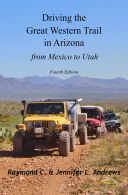Off-Road in Arizona
Arizona's East-West Trail: A Backcountry Challenge
Photographs Contact Us Home
Kindle Edition $9.99
The East-West Trail in Arizona
by Gary Keller
(reprinted from the guidebook, Arizona's East-West Trail: A Backcountry Challenge)
Three or four of us, all over 60 years old, get together twice a year for eight to ten days to do backcountry exploring in different places. We call these all male, spring and fall outings “Billy Goat” trips. We make beds in our Jeeps so we can sleep where it is warmer and dryer. We explore the unknown, at least unknown to us. While others may have traveled these trails before, we know nothing of their experiences. And if we come across a seemingly impassable obstacle, we find our way around or over it. If not, a new challenge is before us. Challenges are not something to shy away from; they are life experiences of a greater day.
Often we are apprehensive of what lies ahead. Sometimes our apprehension of almost impassable obstacles is what draws us here. It’s not the destination, it’s the challenge and experiences that are important for us. That’s the reward.
With the East-West Trail, I know now we are treading upon our own trail.
I had been working on the Great Western Trail since 1986, and in 1998 I started looking into the feasibility of another 4-Wheel drive trail connecting backcountry roads to form a route from New Mexico to California. Jerry Huddlestun with his brand new 1998 Jeep Wrangler, and me with my 1977 CJ5 started in Wikieup, AZ, where we found an east/west passage over the south end of the Hualapai Mountains on the Hualapai Mountain Road that headed north toward Kingman, AZ. We camped in the Wild Cow Spring Campground the first night. Jerry didn’t want to get his new Jeep scratched so we cut brush for a half mile as we headed east.
In 1999 Jerry, Jess Chinn and I started in Wikieup and headed east to find a route to Wickenburg, AZ. That same year we made the connection from Wickenburg to Crown King. We ran many other sections in the following years and always planned to connect them together to make one continuous route.
In 2015 while attending a trails meeting at Arizona State Parks and Trails, the trails manager Skip Varney asked if anyone was interested in adding an East-West Trail across Arizona to their Statewide Trails Plan. Other members were already working on the Arizona Piece Trail, the Lasso Trail, and the one we have been working on since 1986, the Great Western Trail. After working on the East–West Trail for eighteen years, I volunteered to put its sections together with help from my son Brian who ran all the sections four times, and Ray Andrews, author of the Great Western Trail guidebooks. Brian started 4-wheeling a week before he was born and was back 4-wheeling four weeks later. He was almost born in a Jeep. Others that helped over the years were my wife Dean, Jerry and Cathie Huddlestun, Jess and Jacquie Chinn, Dan and Geri Talbot, Larry Blau and Richard Friese.
The Arizona East–West Trail starts or ends near Alpine, Arizona. It heads south from Luna Lake down the Blue River, dips into New Mexico for about a mile, and then back to Arizona. Deer, elk and the Mexican Gray Wolf are abundant in the area. The trail crosses the center of the state through Alpine, Pinetop, Lakeside, Forest Lakes, Punkin Center, Fountain Hills, Carefree, Rock Springs, Black Canyon City, Bumble Bee, Cleator, Crown King, Wickenburg, Octave, Stanton, Hillside, Bagdad, Wikieup, Kingman, Oatman, Bullhead City, and starts or ends at Avi Casino in the southern tip of Nevada along the Colorado River. It has numerous loops, alternates, and bypasses. Along the drive you will see mining camps, historical cabins, relics, points of interest, and one memorial. From Avi Casino you can hop on the Mojave Military Trail and follow it all the way to Barstow, California. Very little of it is on pavement, and then only to connect to the next section trailhead. Some roads are heavily traveled and some are lightly traveled, but most are traveled very little.
The Trail shares sections of FR 300 (General Crook Trail) and the Arizona Peace Trail from Wikieup to Kingman. We will fine tune some areas, add points of interest, bypasses and side loop trails, and we will include many Arizona State Parks. The Trail now has eight segments, or nine if you include the Mojave Trail, and you can travel it all at once or one segment at a time. It has 4WD trails, slow dirt roads, fast dirt roads, and where no backcountry trail exists, limited highway travel. It crosses three national forests, two BLM administered lands, Arizona State Trust Lands, Auga Fria National Monument, and shares segments of the Great Western Trail and the General Crook Trail. The scenery ranges from high altitude pine forests to low desert washes.
The East–West Trail needs federal agency approval before we can put up roadside signs to identify it, but we have already designed its logo. It will have one Main Route, which we choose to use for the first guidebook, but we'll add side loops, bypasses and points of interest when they become available. The first of these, already in the planning stage, will be the 19 HOTSHOT MEMORIAL LOOP, which starts at Stanton, AZ, goes north to Yarnell, down 89A to the memorial, and then continues on 89A to Hillside. No formal map exists at this time, but we plan on creating one this year with the help of Arizona State Parks and Trails. Ray Andrews has prepared a guidebook which contains maps, waypoints, and trail descriptions.
Now for those of you who are looking for something to do, I’ve figured out how you can have a great vacation this year. Just plan a 4-wheel drive trip traversing the entire East–West Trail, the first east/west, long distance, motorized/non-motorized trail of its kind in Arizona. If you don't have a lot of time, you can travel sections of it using other forms of transportation, such as ATVs, Side-by-Sides (UTV), trail bikes, hiking, snowmobiles, mountain bikes, cross-country skiing or horse back. You could stop at many beautiful camping spots along the way, or take advantage of lower motel rates and restaurants in the off-season to support rural business. You can enjoy warmer weather in the high country and cooler in the low country. This makes for a longer vacation every year.
The best time to travel the entire route, which allows you to experience Arizona from the inside out with extreme sightseeing, is in the spring or fall. The lower sections may be too hot in the summer and the high sections too deep in snow in the winter. Many sections are prone to flash flooding during monsoon or spring storms, and some have roads you should not travel when they are wet or muddy.
If you decide to drive the entire trail at one time, plan on spending eight to ten days to drive the approximately 750 miles from border to border in a 4WD Jeep type vehicle. You should travel in three to five vehicle caravans for safety, and be prepared to trail camp in some sections. You can find lodging, gas, and food off the trail.
Enjoy your trip!



